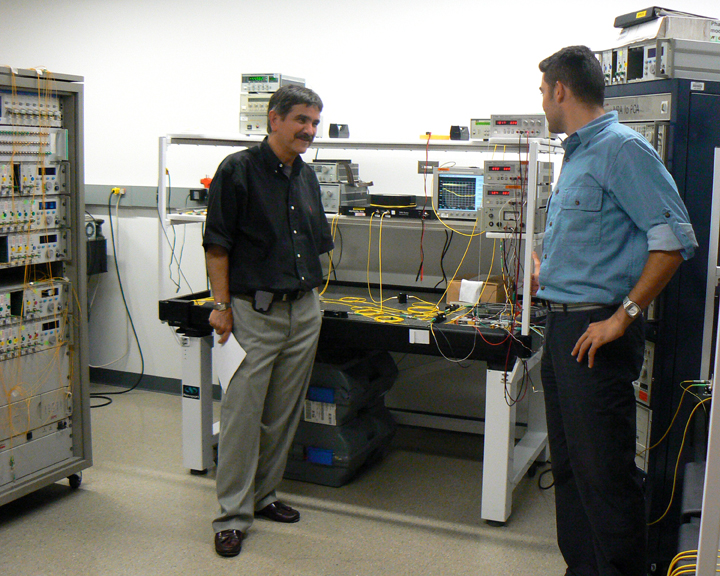NSF Launches an ERC for Integrated Access Networks (CIAN)
September 22, 2008
NSF Launches an Engineering Research Center to Develop Fast, Flexible, and Affordable Communication Networks
The National Science Foundation (NSF) announces an award to the University of Arizona and its partners to establish a new NSF Engineering Research Center (ERC): NSF ERC for Integrated Access Networks (CIAN). CIAN will develop interdisciplinary research and education programs that address an important societal need and provide the foundation for new industries through innovation. NSF will invest $18.5 million in the Center over the next five years.Since 1985 the ERC program has fostered broad-based research and education collaborations in close partnership with industry that focus on making technological breakthroughs and developing new products and services. A new generation of five NSF ERCs will place a greater emphasis on innovation and entrepreneurship and on international collaboration and cultural exchange.
"The Gen-3 ERCs have been designed to build on the well-developed understanding laid down by the two previous generations of ERCs," says Lynn Preston, the leader of the ERC Program. "We have added to Gen-3 ERCs several new dimensions designed to speed the innovation process and prepare engineering graduates who are innovative, creative, and understand how to function in a global economy where engineering talent is broadly distributed throughout the world. We expect these ERCs to make even more significant impacts on the competitiveness of U.S. industry than their predecessors."
CIAN will conduct research to create transformative technologies for optical access networks, at the edges of communication networks, that offer dramatically improved performance and expanded capabilities. An access network is the portion of a network between the end user and the core of the network, where optical fibers then transport information over long distances. CIAN seeks to develop new technologies for optical access networks by using integrated chip-based nanostructures, silicon nanophotonic devices, and new optical materials. These technologies will enable virtually any application (including those for multimedia streaming) in any location to seamlessly and efficiently interact with core networks in a cost-effective manner.
CIAN will be based at the University of Arizona and will have nine university partners in the U.S.:
- California Institute of Technology
- Columbia University
- Norfolk State University
- Stanford University
- Tuskegee University
- University of California, Berkeley
- University of California, Los Angeles
- University of California, San Diego
- University of Southern California
Friedrich-Alexander University in Germany, Hebrew University of Jerusalem Israel, and Helsinki University of Technology in Finland will contribute additional expertise and international perspectives.
More than 30 industry partners, which range from small start-up firms to Fortune 500 companies, will guide strategic planning, spur innovation, and provide university students with first-hand experience in entrepreneurship. CIAN will also work with two local organizations-the Arizona Center for Innovation and the Small Business Development Center at Pima Community College-to stimulate technology transfer.
Cecile J. Gonzalez, National Science Foundation, cjgonzal@nsf.gov
Media Contacts
Joshua A. Chamot, NSF, (703) 292-7730, jchamot@nsf.gov
Jeff Harrison, University of Arizona, (520) 626-4386, jeffh@u.arizona.edu
Program Contacts
Lynn Preston, NSF, (703) 292-5358, lpreston@nsf.gov
Lawrence Goldberg, NSF, (703) 292-8339, lgoldber@nsf.gov
Principal Investigator
Nasser Peyghambarian, University of Arizona, (520) 621-4649, nnp@u.arizona.edu
The U.S. National Science Foundation propels the nation forward by advancing fundamental research in all fields of science and engineering. NSF supports research and people by providing facilities, instruments and funding to support their ingenuity and sustain the U.S. as a global leader in research and innovation. With a fiscal year 2023 budget of $9.5 billion, NSF funds reach all 50 states through grants to nearly 2,000 colleges, universities and institutions. Each year, NSF receives more than 40,000 competitive proposals and makes about 11,000 new awards. Those awards include support for cooperative research with industry, Arctic and Antarctic research and operations, and U.S. participation in international scientific efforts.
Connect with us online
NSF website: nsf.gov
NSF News: nsf.gov/news
For News Media: nsf.gov/news/newsroom
Statistics: nsf.gov/statistics/
Awards database: nsf.gov/awardsearch/
Follow us on social
Twitter: twitter.com/NSF
Facebook: facebook.com/US.NSF
Instagram: instagram.com/nsfgov



